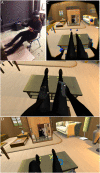A Virtual Out-of-Body Experience Reduces Fear of Death
- PMID: 28068368
- PMCID: PMC5221792
- DOI: 10.1371/journal.pone.0169343
A Virtual Out-of-Body Experience Reduces Fear of Death
Abstract
Immersive virtual reality can be used to visually substitute a person's real body by a life-sized virtual body (VB) that is seen from first person perspective. Using real-time motion capture the VB can be programmed to move synchronously with the real body (visuomotor synchrony), and also virtual objects seen to strike the VB can be felt through corresponding vibrotactile stimulation on the actual body (visuotactile synchrony). This setup typically gives rise to a strong perceptual illusion of ownership over the VB. When the viewpoint is lifted up and out of the VB so that it is seen below this may result in an out-of-body experience (OBE). In a two-factor between-groups experiment with 16 female participants per group we tested how fear of death might be influenced by two different methods for producing an OBE. In an initial embodiment phase where both groups experienced the same multisensory stimuli there was a strong feeling of body ownership. Then the viewpoint was lifted up and behind the VB. In the experimental group once the viewpoint was out of the VB there was no further connection with it (no visuomotor or visuotactile synchrony). In a control condition, although the viewpoint was in the identical place as in the experimental group, visuomotor and visuotactile synchrony continued. While both groups reported high scores on a question about their OBE illusion, the experimental group had a greater feeling of disownership towards the VB below compared to the control group, in line with previous findings. Fear of death in the experimental group was found to be lower than in the control group. This is in line with previous reports that naturally occurring OBEs are often associated with enhanced belief in life after death.
Conflict of interest statement
The authors have declared that no competing interests exist.
Figures










Similar articles
-
Embodiment in a virtual body that speaks produces agency over the speaking but does not necessarily influence subsequent real speaking.Sci Rep. 2017 Oct 27;7(1):14227. doi: 10.1038/s41598-017-14620-5. Sci Rep. 2017. PMID: 29079802 Free PMC article.
-
First person experience of body transfer in virtual reality.PLoS One. 2010 May 12;5(5):e10564. doi: 10.1371/journal.pone.0010564. PLoS One. 2010. PMID: 20485681 Free PMC article.
-
Drumming in immersive virtual reality: the body shapes the way we play.IEEE Trans Vis Comput Graph. 2013 Apr;19(4):597-605. doi: 10.1109/TVCG.2013.29. IEEE Trans Vis Comput Graph. 2013. PMID: 23428444
-
The rubber hand illusion and its application to clinical neuroscience.J Clin Neurosci. 2011 Dec;18(12):1596-601. doi: 10.1016/j.jocn.2011.05.008. Epub 2011 Oct 13. J Clin Neurosci. 2011. PMID: 22000838 Review.
-
Experimental and correlational studies of the fear of death.Psychol Bull. 1967 Jan;67(1):27-36. doi: 10.1037/h0024068. Psychol Bull. 1967. PMID: 5340785 Review. No abstract available.
Cited by
-
The Onset Time of the Ownership Sensation in the Moving Rubber Hand Illusion.Front Psychol. 2017 Mar 10;8:344. doi: 10.3389/fpsyg.2017.00344. eCollection 2017. Front Psychol. 2017. PMID: 28344566 Free PMC article.
-
Clinical Application of Digital Technologies in Adolescent and Young Adult Oncology Supportive Care.J Adolesc Young Adult Oncol. 2021 Apr;10(2):127-130. doi: 10.1089/jayao.2020.0153. Epub 2020 Dec 9. J Adolesc Young Adult Oncol. 2021. PMID: 33296259 Free PMC article. No abstract available.
-
Comparison of psychedelic and near-death or other non-ordinary experiences in changing attitudes about death and dying.PLoS One. 2022 Aug 24;17(8):e0271926. doi: 10.1371/journal.pone.0271926. eCollection 2022. PLoS One. 2022. PMID: 36001643 Free PMC article.
-
Technological Competence Is a Pre-condition for Effective Implementation of Virtual Reality Head Mounted Displays in Human Neuroscience: A Technological Review and Meta-Analysis.Front Hum Neurosci. 2019 Oct 2;13:342. doi: 10.3389/fnhum.2019.00342. eCollection 2019. Front Hum Neurosci. 2019. PMID: 31632256 Free PMC article.
-
"Thanatophobia": Physician's Perspective of Dealing with Patients with Fear of Death.J Nat Sci Biol Med. 2018 Jan-Jun;9(1):103-104. doi: 10.4103/jnsbm.JNSBM_102_17. J Nat Sci Biol Med. 2018. PMID: 29456404 Free PMC article. No abstract available.
References
-
- Parnia S, Waller DG, Yeates R, Fenwick P. A qualitative and quantitative study of the incidence, features and aetiology of near death experiences in cardiac arrest survivors. Resuscitation. 2001;48(2):149–56. - PubMed
-
- Blanke O, Dieguez S. Leaving body and life behind: Out-of-body and near-death experience In: Laureys S, T G, editors. The neurology of consciousness: Cognitive neuroscience and neuropathology: Elsevier Academic Press; 2009. p. 303–25.
-
- Agrillo C. Near-death experience: out-of-body and out-of-brain? Rev Gen Psychol. 2011;15(1):1–10.
-
- Moody RA. Life After Life: The investigation of a phenomenon, survival of bodily death: Random House; 2001.
-
- Blackmore SJ. Beyond the body: An investigation of out-of-the-body experiences: Academy Chicago Publishers; 1982.
MeSH terms
LinkOut - more resources
Full Text Sources
Other Literature Sources
Medical

